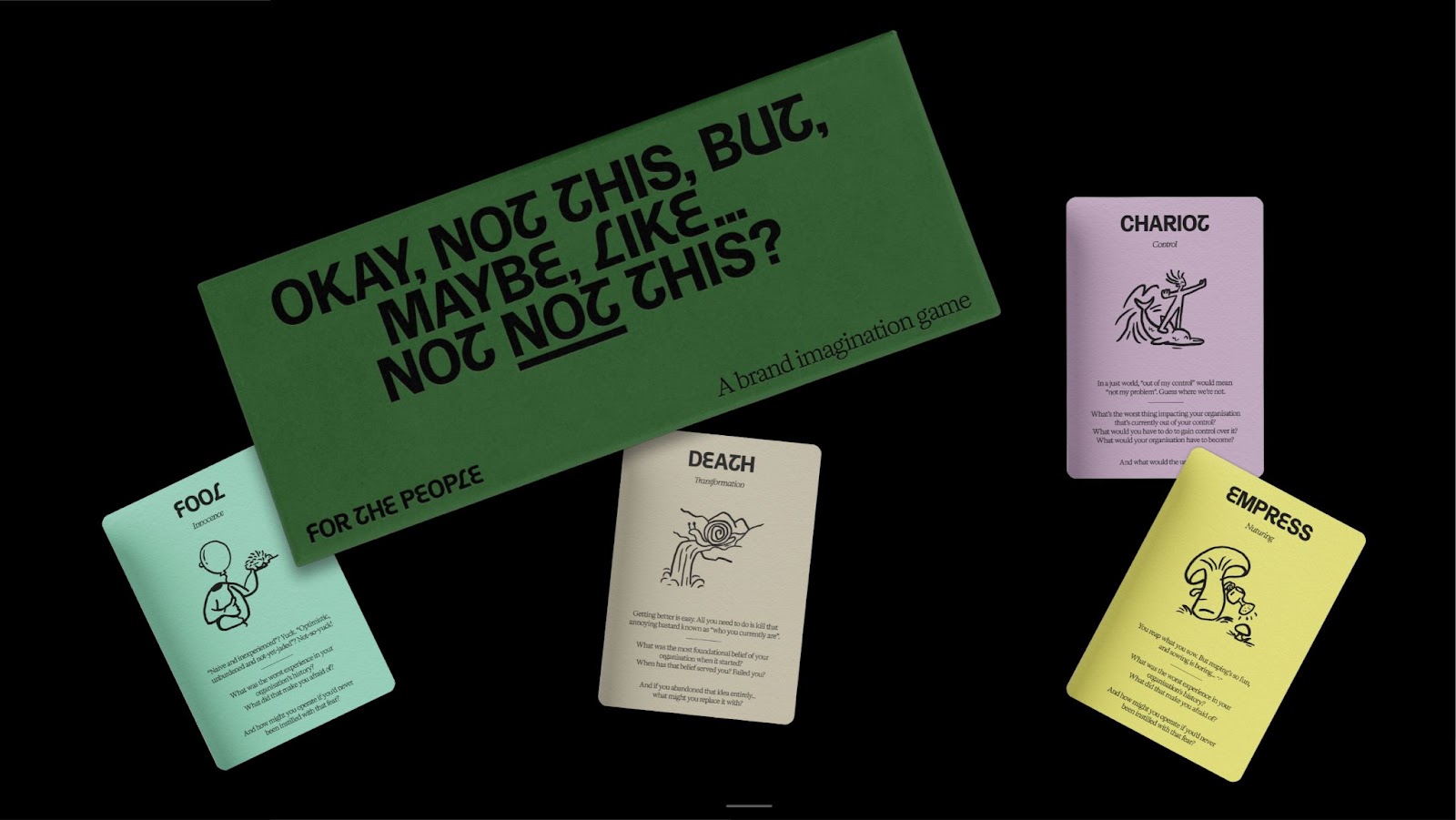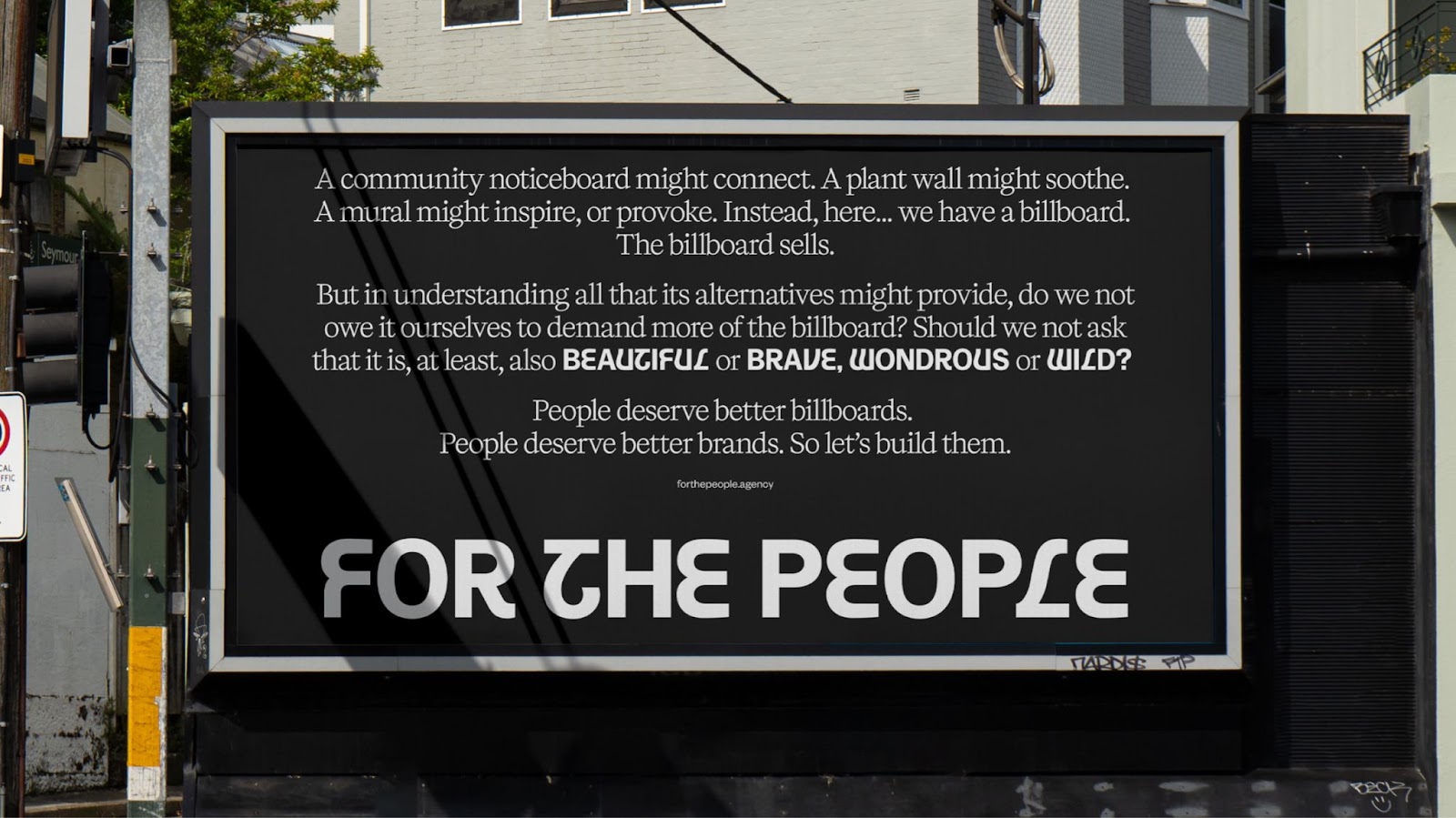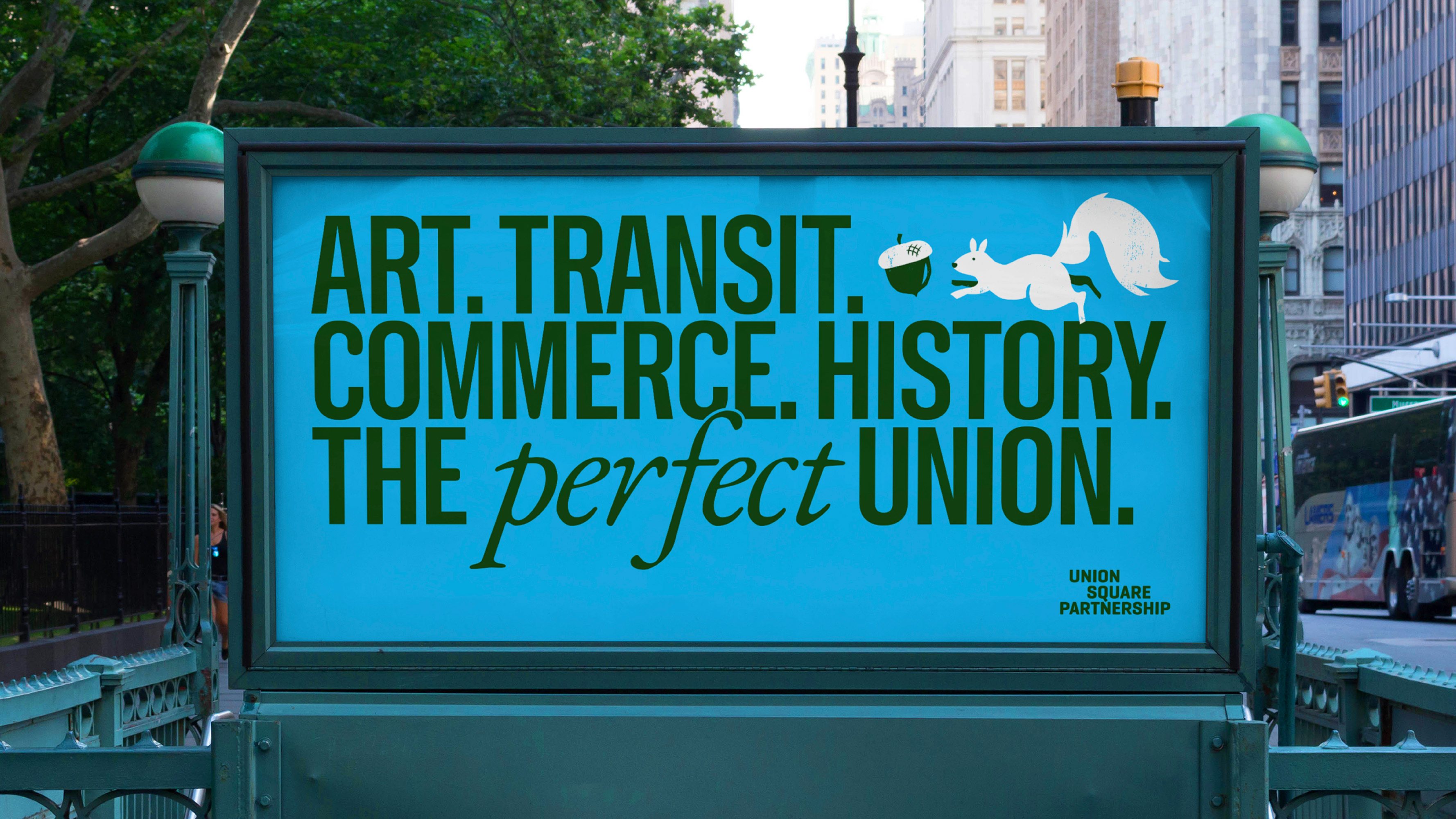I messed up. For about – let me just check my watch, here – about, uh… ten years.
Whoops.
Let’s wind back the clock.
“We weren’t really looking for a writer”
2015: For The People! A new, tiny, independent brand agency, started in Sydney, Australia by three guys with plenty of big agency experience. They have a manifesto on their website, about the particular ways in which they’d like to do things differently. I dig it. I send an email. I get an interview with one of the founders. Then another one. Then the last one. They go well. But then: “We weren’t really looking for a writer…”
I make the case for why they’re wrong. I tell them I want to do something a bit different – not just Brand Voice, but “storytelling” – something a bit more intrinsic than modulating tone, helping to define the essential stories of brands, using archetypal story structure. They’re convinced… or, at very least, curious. Either way, a victory. I’m in.
A few months later, a question from them: “Should we define our Brand Voice?”
Me, very casually making a very big mistake: “Naaaah.”
They (quite reasonably) ask me to elaborate. I say that we’re a particularly small agency, and I can just write whatever we need to write, so the agency voice can just kinda be, well… my voice! They’re convinced… or, at very least, too busy to argue. Either way, a victory.
And thus, one rather large can gets its first kick down a rather long road.

“It’s just kind of a vibe thing, you know?”
Flashforward maybe five years. Now, it’s not just me – I have two other Storytellers on my team. They’re great, but I still handle most external agency communication myself – until I can’t any more. I have too many responsibilities, I’m just too busy. “You can’t do it all,” I’m told. Repeatedly. Ughhh. Fine. I reluctantly agree to do some delegating.
“Maybe now would be a good time to define our Brand Voice?”
I say “Naaaah.” I say that the other Storytellers know the style I’ve been using and can handle it without documentation. “It’s just kind of a vibe thing, you know?”
Kick.

Last year. We’re working on a proper, full rebrand for the agency. The first time we’ve done anything like it. Again, the suggestion is made: “We might as well define the Brand Voice while we’re working on the design, yeah?”
I say (say it with me now) “Naaaah.” Unfortunately, my old excuses won’t hold water – we’re too big for even a team of Storytellers to handle all of the writing. The whole team is going to have to be part of it. But never fear, I have a new excuse: we’ve got a big focus on letting the personalities of our people shine through, we want everyone to have a platform and a perspective… so everyone can just write in their own voice. “It’s not a cop out,” I tell myself. “It’s actually a clever and — dare I say — egalitarian solution!”
But in the following days, I mull it over… and then I return to the team with an embarrassing admission: “I think I’ve made a mistake.”
Of course I’d made a mistake! Yes, we’ll have lots of opportunities for the team to speak as themselves, about topics they’re passionate about – but there are also very many situations where we need to speak on behalf of the whole agency. It wouldn’t make sense for, say, the page on our website about our process to be written from one person’s perspective.
We needed a Brand Voice. The work I should’ve done ten years ago. Sadly… we couldn’t afford for the can to be kicked any further.
“I can’t do it all”
Before I could really get into the process, I needed to engage in some self-reflection. If I kept declining to build a proper Brand Voice for the agency’s brand, but kept giving different reasons why… then there was probably a different, truer reason beneath the surface.
And I think the honest (and slightly shameful) truth is that it was always a mix of two things: 1) I was always very busy, and
2) it was always going to be quite hard.
Why was it going to be hard, though? Why was it always such an imposing prospect, lingering in the distance?
The answer I’ve arrived at: because the work we do is hard… at least when we do it well! It involves interrogating complex people, their complex relationships and interactions with each other, and the complex culture that results. It involves excavating genuine points of distinction, and cutting away the surface-level and decidedly-non differentiating. It involves time, and research, and a lot of consideration. And the reason it felt more overwhelming in this context was… because I was expecting myself to do it alone, despite that never being how we approach client projects!
When we do projects for them, we all work together – Storytellers, Designers and Strategists – to do the research, understand the context, crack the big ideas. “I can’t do it all.” I never could. Sometimes the obvious lessons are the hardest to internalise.

“Let’s go back to the start”
Thankfully, I wasn’t the only one to make this mistake. In working on the design part of the rebrand, the design team had jumped right into it, but struggled with substance, and come to a parallel realisation to my own – why would we jump into creative development without a strategic foundation? Why would we not apply the rigour we do for our clients to our own brand project?
“Let’s go back to the start.” A hard thing to hear, but undoubtedly the right call. Under the leadership of our incredible Strategy Director Amanda Gordon, we went back and started the process over. Finally, finally… we’d do it right.
The process did exactly what it was supposed to – it helped us better understand ourselves, what makes us different, what we wanted, and where we’re headed. And from there, building out a Brand Voice for For The People came quite easily.
You can check it out here if you’d like, but I’m not sure the specifics really matter as much as the lesson: there are no shortcuts, and we’re not special just because it’s our own field of work. The process is the process is the process. There’s no avoiding it, nor should we want to avoid it – it’s great! It works! And it’s the only way to produce meaningful work.
Now, if someone could send this article back in time to me from ten years ago, that’d be swell. It’d really save me some angst.
Creative Credits
Agency: For The People
For The People Storytelling Team: Mat Groom, Arielle Bodenstein, Meredith Forrester
Mat Groom writes comics for Marvel, DC + Image Comics and was the Head of Storytelling at For The People until very recently. He’s now figuring out what’s next, but if he ends up at an agency that needs a Brand Voice, he’ll be much more proactive this time, he swears.
I messed up. For about – let me just check my watch, here – about, uh… ten years.
Whoops.
Let’s wind back the clock.
“We weren’t really looking for a writer”
2015: For The People! A new, tiny, independent brand agency, started in Sydney, Australia by three guys with plenty of big agency experience. They have a manifesto on their website, about the particular ways in which they’d like to do things differently. I dig it. I send an email. I get an interview with one of the founders. Then another one. Then the last one. They go well. But then: “We weren’t really looking for a writer…”
I make the case for why they’re wrong. I tell them I want to do something a bit different – not just Brand Voice, but “storytelling” – something a bit more intrinsic than modulating tone, helping to define the essential stories of brands, using archetypal story structure. They’re convinced… or, at very least, curious. Either way, a victory. I’m in.
A few months later, a question from them: “Should we define our Brand Voice?”
Me, very casually making a very big mistake: “Naaaah.”
They (quite reasonably) ask me to elaborate. I say that we’re a particularly small agency, and I can just write whatever we need to write, so the agency voice can just kinda be, well… my voice! They’re convinced… or, at very least, too busy to argue. Either way, a victory.
And thus, one rather large can gets its first kick down a rather long road.

“It’s just kind of a vibe thing, you know?”
Flashforward maybe five years. Now, it’s not just me – I have two other Storytellers on my team. They’re great, but I still handle most external agency communication myself – until I can’t any more. I have too many responsibilities, I’m just too busy. “You can’t do it all,” I’m told. Repeatedly. Ughhh. Fine. I reluctantly agree to do some delegating.
“Maybe now would be a good time to define our Brand Voice?”
I say “Naaaah.” I say that the other Storytellers know the style I’ve been using and can handle it without documentation. “It’s just kind of a vibe thing, you know?”
Kick.

Last year. We’re working on a proper, full rebrand for the agency. The first time we’ve done anything like it. Again, the suggestion is made: “We might as well define the Brand Voice while we’re working on the design, yeah?”
I say (say it with me now) “Naaaah.” Unfortunately, my old excuses won’t hold water – we’re too big for even a team of Storytellers to handle all of the writing. The whole team is going to have to be part of it. But never fear, I have a new excuse: we’ve got a big focus on letting the personalities of our people shine through, we want everyone to have a platform and a perspective… so everyone can just write in their own voice. “It’s not a cop out,” I tell myself. “It’s actually a clever and — dare I say — egalitarian solution!”
But in the following days, I mull it over… and then I return to the team with an embarrassing admission: “I think I’ve made a mistake.”
Of course I’d made a mistake! Yes, we’ll have lots of opportunities for the team to speak as themselves, about topics they’re passionate about – but there are also very many situations where we need to speak on behalf of the whole agency. It wouldn’t make sense for, say, the page on our website about our process to be written from one person’s perspective.
We needed a Brand Voice. The work I should’ve done ten years ago. Sadly… we couldn’t afford for the can to be kicked any further.
“I can’t do it all”
Before I could really get into the process, I needed to engage in some self-reflection. If I kept declining to build a proper Brand Voice for the agency’s brand, but kept giving different reasons why… then there was probably a different, truer reason beneath the surface.
And I think the honest (and slightly shameful) truth is that it was always a mix of two things: 1) I was always very busy, and
2) it was always going to be quite hard.
Why was it going to be hard, though? Why was it always such an imposing prospect, lingering in the distance?
The answer I’ve arrived at: because the work we do is hard… at least when we do it well! It involves interrogating complex people, their complex relationships and interactions with each other, and the complex culture that results. It involves excavating genuine points of distinction, and cutting away the surface-level and decidedly-non differentiating. It involves time, and research, and a lot of consideration. And the reason it felt more overwhelming in this context was… because I was expecting myself to do it alone, despite that never being how we approach client projects!
When we do projects for them, we all work together – Storytellers, Designers and Strategists – to do the research, understand the context, crack the big ideas. “I can’t do it all.” I never could. Sometimes the obvious lessons are the hardest to internalise.

“Let’s go back to the start”
Thankfully, I wasn’t the only one to make this mistake. In working on the design part of the rebrand, the design team had jumped right into it, but struggled with substance, and come to a parallel realisation to my own – why would we jump into creative development without a strategic foundation? Why would we not apply the rigour we do for our clients to our own brand project?
“Let’s go back to the start.” A hard thing to hear, but undoubtedly the right call. Under the leadership of our incredible Strategy Director Amanda Gordon, we went back and started the process over. Finally, finally… we’d do it right.
The process did exactly what it was supposed to – it helped us better understand ourselves, what makes us different, what we wanted, and where we’re headed. And from there, building out a Brand Voice for For The People came quite easily.
You can check it out here if you’d like, but I’m not sure the specifics really matter as much as the lesson: there are no shortcuts, and we’re not special just because it’s our own field of work. The process is the process is the process. There’s no avoiding it, nor should we want to avoid it – it’s great! It works! And it’s the only way to produce meaningful work.
Now, if someone could send this article back in time to me from ten years ago, that’d be swell. It’d really save me some angst.
Creative Credits
Agency: For The People
For The People Storytelling Team: Mat Groom, Arielle Bodenstein, Meredith Forrester
Mat Groom writes comics for Marvel, DC + Image Comics and was the Head of Storytelling at For The People until very recently. He’s now figuring out what’s next, but if he ends up at an agency that needs a Brand Voice, he’ll be much more proactive this time, he swears.





